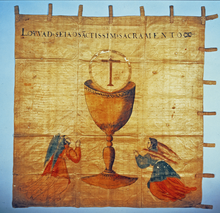Amakusa Shirō


Amakusa Shirō (jap. 天草 四郎; wirklicher Name: Masuda Tokisada (益田 時貞); * um 1621; † 12. April 1638) war der Führer des Shimabara-Aufstandes im Japan der Edo-Zeit.
Der Sohn eines früheren Gefolgsmannes des Konishi-Clans wurde von den Führern des Aufstandes als der „Vierte Sohn des Himmels“ angesehen, der nach den Vorhersagen von Francisco de Xavier y Jassu kommen würde, um die Christianisierung Japans zu führen.
Amakusa Shirō leitete die Verteidigung der Burg Hara und starb, als sie nach monatelanger Belagerung fiel. Sein Kopf wurde lange Zeit auf einem Speer aufgespießt in Nagasaki ausgestellt, um andere mögliche christliche Rebellen abzuschrecken.
Literatur
- Roland Habersetzer: Amakusa Shirō – Gottes Samurai: Der Aufstand von Shimabara. Historischer Roman. Palisander Verlag, 2013, ISBN 978-3-938305-19-5.
- Ivan Morris: Samurai oder Von der Würde des Scheiterns: Tragische Helden in der Geschichte Japans, Insel Verlag, Frankfurt am Main und Leipzig 1999
- Harald Pöcher: Kriege und Schlachten in Japan, die Geschichte schrieben: Von den Anfängen bis 1853, Lit Verlag, Münster 2009
| Personendaten | |
|---|---|
| NAME | Amakusa Shirō |
| ALTERNATIVNAMEN | 天草 四郎 (japanisch); Masuda Tokisada (wirklicher Name); 益田 時貞 (japanisch, wirklicher Name) |
| KURZBESCHREIBUNG | Führer des Shimabara-Aufstandes im Japan der Edo-Zeit |
| GEBURTSDATUM | um 1621 |
| STERBEDATUM | 12. April 1638 |
Auf dieser Seite verwendete Medien
Amakusa Shirō, from the series Biographies of Valiant Drunken Tigers (Keisei suikoden / 竸勢醉虎傳), Woodblock print
The Amakusa Kirishitan Memorial Hall's "Amakusa Shiro Battle Flag" is said to have been used by Amakusa Shiro during the Amakusa-Shimabara Rebellion in 1637. It is an important cultural property of Japan and is said to be one of the world's three major holy flags along with the Western European crusader flag and the Joan of Arc flag. The flag bears marks of blood and arrows from battle, and in the center of the flag is a chalice filled with wine, above which is a large cross in the Eucharist Bread, representing Christ. The cross has a dry shape, and in the upper horizontal part of it is written the initials "INRI", which means "Jesus of Nazareth, King of the Jews". Two angels are flanking them. At the top of the flag is an inscription in old Portuguese: "LOVVADo SEIA O SĀCTISSIMo SACRAMENTO" which means "Praise the Most Precious Sacrament of the Eucharist." There is no Japanese written, but the author is said to be the work of Yamada Emosaku (山田右衛門作, c.1598- 1657), who fought alongside Shiro Amakusa and was the only survivor.


